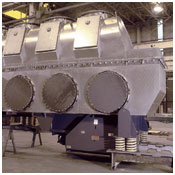
Posted on February 20th, 2024 by Carrier Vibrating
In the world of industrial processing, there’s a certain piece of equipment that stands out for its innovation and efficiency: the vibrating fluid bed. This intricate machine is crucial in various industries, including glass manufacturing. Yet, despite its widespread use, its operation remains a mystery to many. We hope to demystify the vibrating fluid bed, explaining how it works and why it’s an essential tool for many businesses.
What is a Vibrating Fluid Bed?
A vibrating fluid bed is a piece of industrial machinery that serves multiple purposes, including drying, cooling, and heating among others. It operates based on the concept of fluidization. This process involves sending a process gas – typically air – straight through a layer of solid materials using a perforated plate or similar fluidizing agent.
Just as quicksand can transform from solid to liquid-like properties when saturated with pressurized water, so does the material in a vibrating fluid bed behave like a fluid when air is introduced from below. This phenomenon—known as fluidization— reduces friction among particles and allows for uniform heating, drying, or cooling.
How Does a Vibrating Fluid Bed Work?
The basic operation of a vibrating fluid bed involves several key steps:
- Air Heating and Supply: The process begins with natural air being taken in, filtered, and heated to the desired temperature based on the product’s characteristics. This heated air becomes the drying or cooling medium for the machine.
- Product Introduction: Wet or hot products are introduced into the fluidized bed through an inlet or feeder.
- Vibration Mechanism: The bed is then set into motion by vibration motors located either at both sides or at one end of the machine.
- Fluidization: As the bed moves horizontally in a parabolic motion, heated or cooled air is forced up through the perforated plate under the product. This facilitates heat convection exchange and causes the product to fluidize.
- Continuous Suspension: As air flows through the bed, the product remains suspended on the bed plate, ensuring efficient drying or cooling.
- Vapor and Powder Removal: Any water vapor or fine powder generated during the process is discharged through an upward pipeline, typically aided by an induced draft fan. Dust is then collected using a cyclone separator or bag filter.
Some fluidized beds are also designed with integrated beds for both drying and cooling, allowing for rapid product cooling to prevent moisture reabsorption before packaging.
Advantages of Vibrating Fluid Beds
One of the main benefits of vibrating fluid beds is their energy efficiency. They require lower fluidizing velocities compared to other types of dryers, which translates to reduced energy consumption.
Moreover, they allow for precise control over residence time—the period that the product spends in the dryer—which ensures consistent and uniform drying or cooling of each particle.
Vibrating fluid beds are also designed for easy cleaning and maintenance, with options for clean-in-place (CIP) systems.
Additionally, they can process a wide range of materials—from granular solids to powders—making them suitable for various industries, including glass manufacturing.
Vibrating Fluid Beds in the Glass Industry
In the glass industry, vibrating fluid beds are often used for processes such as drying raw materials like silica sand—an essential component in glass manufacturing—before melting. The uniform drying provided by these machines helps ensure the consistency and quality of the final glass product.
Moreover, due to their energy efficiency, vibrating fluid beds can help glass manufacturers reduce their energy costs—a significant concern given that glass manufacturing is an energy-intensive process.
Vibrating fluid beds are versatile pieces of industrial equipment that offer energy efficiency and processing flexibility benefits. By understanding how they work, businesses can make informed decisions about whether this technology might be a good fit for their operations. Contact us for more information.






